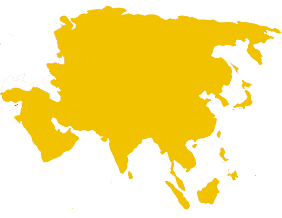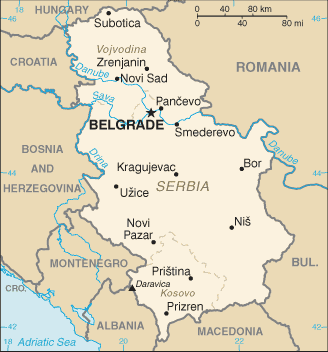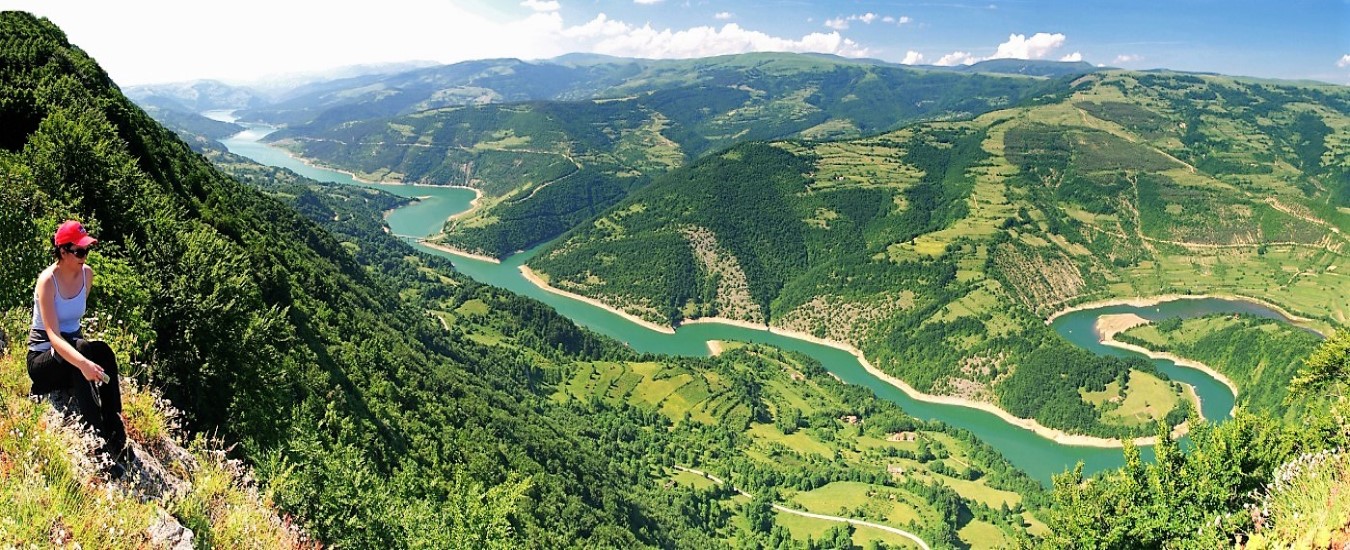
North America
& Caribbean |

South America
|

Africa
|

Asia
|

Europe
|

Australia &
Oceania |

Country Rankings
|

Beyond
Earth |
|
mail
ContactUs
|
|
info
AboutUs
|

Flag
National anthem

Coat of arms

Country location map

Country static map
Country dynamic (scrollable) map
Current weather & time
-
infoGeneral informationkeyboard_arrow_up
- Country common name: Serbia
- Country official name: (Serbian: Republika Srbija) Republic of Serbia
- Continent: Europe
- 3-Letter abbreviation: SRB
- 2-Letter abbreviation: RS
- Capital: Belgrade
- Major cities: 1.398 million BELGRADE (Serbian: BEOGRAD), capital; 277,522 Novi Sad; 260,237 Nis; 150,835 Kragujevac
- Currency: Serbian dinar (click for current conversion rates)
- Languages: Serbian (official) 88.1%, Hungarian 3.4%, Bosnian 1.9%, Romani 1.4%, other 3.4%, undeclared or unknown 1.8%
- Motto: "Only Unity Saves the Serbs" (Serbian: "Samo sloga Srbina spasava")
- National holiday(s): National Day (Statehood Day), 15 February (1835), the day the first constitution of the country was adopted
flagGovernmentkeyboard_arrow_up- Chief of state: President Aleksandar VUCIC (since 31 May 2017)
- Head of government: Prime Minister Milos Vucevic (since 2 May 2024)
- Government type: parliamentary republic
insert_photoCountry notes & photographskeyboard_arrow_up{"ops":[{"attributes":{"bold":true},"insert":"Serbia"},{"insert":", officially the "},{"attributes":{"bold":true},"insert":"Republic of Serbia"},{"insert":" (Serbian: Republika Srbija), is a landlocked country in Central and Southeastern Europe, covering the central part of the Balkan Peninsula and the southern part of the Pannonian Plain . It is bordered by Hungary to the north; Romania and Bulgaria to the east; Albania and the Republic of Macedonia to the south; and Montenegro, Croatia and Bosnia and Herzegovina to the west. The capital is Belgrade.\n\nSerbs settled the region by 630 AD, having been invited by the Byzantine emperor Heraclius. Serbs were fully converted to Christianity by 865 AD. They formed four distinct independent kingdoms by the 14th century in Dioclea, Rascia, Syrmia and Bosnia. The medieval Serbian Kingdom, later the Serbian Empire of Czar Stefan Dushan, rose from Byzantine, Bulgarian and Hungarian patronage to become a threat to the very existence of Constantinople itself before succumbing to the Ottoman Empire. Another short-lasting incarnation of the Serbian Empire was the one of Emperor Jovan Nenad in 16th-century Vojvodina, however the state also collapsed to the Ottoman Empire, before finally passing to the Habsburg Empire, where it would remain for centuries to come. Belgrade had indured and repelled several Ottoman invasions and was the last major Balkan city to surrender in 1521, opening the gates of Central Europe - Vojvodina, Hungary and Vienna .\n\nDespite three Austrian occupations and numerous rebellions, 2/3rds of the modern state had remained under Ottoman occupation from the 15th century to the uprisings against Turkish occupation in 1804. Two consequent national revolutions have re-established Serbia (in 1815) as a semi-independent prinicipality, which has expelled the Ottomans in "},{"attributes":{"bold":true},"insert":"1867"},{"insert":", "},{"attributes":{"italic":true},"insert":"de facto"},{"insert":" securing its sovereignty. Formal independence was internationally recognized at the Congress of Berlin in "},{"attributes":{"bold":true},"insert":"1878"},{"insert":". Northern third of the country, Vojvodina , has endured a century long Ottoman occupation before passing to Habsburg Empire in the 17th century, only to proclaim independence from Austria-Hungary in 1918.\n\nVictorious in Balkan wars and both World Wars, for nearly a century Serbia was backbone of various South Slavic states, including the Kingdom of the Serbs, Croats and Slovenes from 1918 to 1941 (renamed the Kingdom of Yugoslavia in 1929), the Socialist Federal Republic of Yugoslavia from 1945 to 1992, the Federal Republic of Yugoslavia from 1992 to 2003, and the State Union of Serbia and Montenegro from 2003 to 2006. After Montenegro narrowly voted for independence from the State Union, Serbia officially proclaimed its independence on June 7, "},{"attributes":{"bold":true},"insert":"2006"},{"insert":", as the successor state to the State Union of Serbia and Montenegro.\n\nTourism in Serbia is mostly based in mountains and villages. The most famous mountain resorts are Zlatibor, Kopaonik, and Tara. There also are a lot of spas in Serbia, one the biggest of which is the Vrnjacka Banja. There is also significant tourism in Belgrade and Novi Sad (the capital of the Vojvodina province), as well to the "},{"attributes":{"italic":true},"insert":"Exit Festival"},{"insert":" and the "},{"attributes":{"italic":true},"insert":"GuÄa"},{"insert":" trumpet festival. \n"}]}terrainGeographic informationkeyboard_arrow_up- Surface area (in km²): 77,474
- Highest point: Midzor 2,169 m
- Neighboring countries: Bosnia and Herzegovina 345 km, Bulgaria 344 km, Croatia 314 km, Hungary 164 km, Kosovo 366 km, Macedonia 101 km, Montenegro 157 km, Romania 531 km
- Neighboring seas and oceans: None
- Climate: in the north, continental climate (cold winters and hot, humid summers with well-distributed rainfall); in other parts, continental and Mediterranean climate (relatively cold winters with heavy snowfall and hot, dry summers and autumns)
radioRadio stationskeyboard_arrow_upsupervised_user_circlePopulationkeyboard_arrow_up- Population: 7,012,165
- Population density (inhabitants per km²): 90.5
- Average age (in years): 43.4
- Life expectancy at birth (in years): 76.3
- Ethnicity: Serb 83.3%, Hungarian 3.5%, Romani 2.1%, Bosniak 2%, other 5.7%, undeclared or unknown 3.4%
- Gross domestic product (GDP) per inhabitant (in US dollars): 18,200
- Cultural practices: There is a strong coffee culture in Serbia. Black coffee ('crna kafa' or 'turska kafa') is served frequently throughout the day.
local_diningPopular food & drinkskeyboard_arrow_up{"ops":[{"attributes":{"bold":true},"insert":"Karadjordje's schnitzel"},{"insert":" (Serbian: "},{"attributes":{"italic":true},"insert":"Karadjordjeva Shnicla"},{"insert":") is a Serbian"},{"attributes":{"bold":true},"insert":" breaded cutlet"},{"insert":" dish named after the 19th century Serbian revolutionary Karadjordje. It is a rolled "},{"attributes":{"italic":true},"insert":"veal "},{"insert":"or "},{"attributes":{"italic":true},"insert":"porksteak"},{"insert":", stuffed with "},{"attributes":{"italic":true},"insert":"kajmak ("},{"insert":"see next"},{"attributes":{"italic":true},"insert":"),"},{"insert":" and then breaded and fried. It is served with roasted potatoes and tartar sauce. The dish is a modern invention, created by chef Mica Stojanovic in 1959.\n"}]}
{"ops":[{"attributes":{"bold":true},"insert":"Kajmak"},{"insert":" is a traditional Serbian cheese product, served as an appetizer or side dish, and sold at food markets (Serbian: "},{"attributes":{"italic":true},"insert":"pijaca"},{"insert":"). It is made of unpasteurized and unhomogenized milk - like a type of unripened \"new\" cheese. Some say it is similar to cream cheese - but it is of course, better tasting (kajmak lovers speak of \"heavenly taste\"). Gets along perfectly with cevapcici"},{"attributes":{"italic":true},"insert":" "},{"insert":"("},{"attributes":{"italic":true},"insert":"cevapi"},{"insert":") and "},{"attributes":{"italic":true},"insert":"pljeskavica "},{"insert":"or with any other meat dish, or you can eat it by itself with flatbread and fresh parsley.\n"}]}
{"ops":[{"attributes":{"bold":true,"link":"https://cyberspace23.com/recipe-display.php?id=4"},"insert":"Cevapcici"},{"attributes":{"bold":true},"insert":" "},{"insert":"or c"},{"attributes":{"italic":true},"insert":"evapi "},{"insert":"are a signature grilled dish in all ex-Yugoslavian countries, namely Serbia, Croatia, Bosnia, Macedonia, Montenegro and Slovenia. The Serbian versions of this delicious mixed meat 'sausage'-style fingers of wonder, are frequently served with "},{"attributes":{"italic":true},"insert":"lepinja"},{"insert":" (pita-like bread), "},{"attributes":{"italic":true},"insert":"kajmak"},{"insert":" (cream cheese in a way, but kajmak is kajmak), and chopped onions.\n"}]}
{"ops":[{"attributes":{"bold":true},"insert":"Riblja chorba "},{"insert":"("},{"attributes":{"italic":true},"insert":"fish stew"},{"insert":") is prepared using a number of different species of high quality fish, plus various herbs and spices. A common variation in many restaurants is "},{"attributes":{"bold":true},"insert":"carp with Serbian pilaff"},{"insert":" (Serbian: "},{"attributes":{"italic":true},"insert":"A!aran sa srpskim pilavom"},{"insert":") - with these ingredients: carp, rice, onion, tomato, white wine, paprika, salt, pepper and lemon. An old saying goes \"A fish needs to swim\" -- a good reason to make certain there is white wine both in the stew and as an accompanying drink.\n"}]}
local_post_officePostage stampskeyboard_arrow_up{"ops":[{"insert":"An "},{"attributes":{"bold":true},"insert":"1880 "},{"insert":"stamp featuring "},{"attributes":{"bold":true},"insert":"Prince Milan"},{"insert":". The Principality of Serbia (Kingdom from 1881) began to issue its own stamps in 1866. This continued until 1920, when its postal system merged with the postal system of the former Austro-Hungarian territories with which it formed the Kingdom of Serbs, Croats and Slovenes (later renamed Yugoslavia). In "},{"attributes":{"bold":true},"insert":"2006"},{"insert":", Serbia began issuing stamps as an independent country.\n"}]}
{"ops":[{"insert":"150 Years since the Birth of "},{"attributes":{"bold":true},"insert":"Mahatma Gandhi"},{"insert":" - commemorative stamp issued in "},{"attributes":{"bold":true},"insert":"2019"},{"insert":"\n"}]}
{"ops":[{"attributes":{"bold":true},"insert":"2020"},{"insert":" Serbia"},{"attributes":{"bold":true},"insert":" Easter stamp"},{"insert":". In Serbia, a dominantly Christian Orthodox country, Easter is celebrated according to the old "},{"attributes":{"italic":true},"insert":"Julian calendar. "},{"insert":"Most other Christian churches celebrate Easter according to the newer Gregorian calendar. Consequently, the Orthodox Easter often occurs at a later date, near the time of the March equinox.\n"}]}
{"ops":[{"attributes":{"bold":true},"insert":"2020"},{"insert":" stamp on the occasion of the 75th anniversary of the sport club "},{"attributes":{"bold":true},"insert":"Crvena Zvezda (Red Star Belgrade)"},{"insert":". Red Star's football (soccer) team is known internationally for its "},{"attributes":{"bold":true},"insert":"1991"},{"insert":" win in the both the "},{"attributes":{"bold":true},"insert":"European Champions Cup"},{"insert":" and the "},{"attributes":{"bold":true},"insert":"World Club Football Cup"},{"insert":".\n"}]}
tap_and_playTelephone & Internet communicationkeyboard_arrow_upkeyboard_arrow_up- Country international telephone code: +381
- Local emergency telephone number(s): 94
- Internet code: .rs, .yu
- Number of Internet users: 6,060,488
- Percentage of Internet-connected population: 86.4%
gradeAlso useful to knowkeyboard_arrow_up- Vaccinations: For recommendations please refer to the World Health Organization (WHO), or the U.S. Centers for Disease Control (CDC) websites.
- Potable/drinkable water: Yes
- International driving permit: Suggested
- Road driving side: Right
-
Electricity/Voltage/Plug type(s):
230 V / 50 Hz / plug type(s): C, F
keyboard_arrow_leftkeyboard_arrow_right10
-

{"ops":[{"attributes":{"bold":true},"insert":"Belgrade"},{"insert":", located at the confluence of the "},{"attributes":{"bold":true},"insert":"Danube "},{"insert":"and "},{"attributes":{"bold":true},"insert":"Sava Rivers"},{"insert":", is the "},{"attributes":{"bold":true},"insert":"capital "},{"insert":"of the Republic of Serbia. The core of old Belgrade - known as "},{"attributes":{"bold":true},"insert":"Kalemegdan "},{"insert":"- is located along the right banks of both the Danube and the Sava Rivers (image center). To the west across the Sava,"},{"attributes":{"bold":true},"insert":" Novi Beograd (New Belgrade)"},{"insert":" was constructed following World War II. The difference in urban patterns between the older parts of Belgrade and Novi Beograd is striking in this astronaut photograph from the International Space Station. Novi Beograd has an open grid structure formed by large developments and buildings such as the Palace of Serbia - a large federal building constructed during the Yugoslav period, now used to house elements of the Serbian Government. By contrast, the older urban fabric of Belgrade is characterized by a denser street grid and numerous smaller structures. Other suburban and residential development (characterized by red rooftops) extends to the south, east, and across the Danube to the north. The location of Belgrade along trade and travel routes between the East and West contributed to both its historical success as a "},{"attributes":{"bold":true},"insert":"center of trade"},{"insert":" and its fate as a "},{"attributes":{"bold":true},"insert":"battleground"},{"insert":". Today, the city is the financial center of Serbia, while Novi Beograd supports one of the largest business districts in southeastern Europe. Image courtesy of NASA.\n"}]}
-

{"ops":[{"attributes":{"bold":true},"insert":"Gamzigrad-Romuliana, Palace of Galerius"},{"insert":". Gamzigrad is an archaeological site, spa resort and UNESCO World Heritage Site located near the city of Zaje?ar. It is the location of the ancient Roman complex of palaces and temples "},{"attributes":{"bold":true},"insert":"Felix Romuliana"},{"insert":", built by Emperor "},{"attributes":{"bold":true},"insert":"Galerius "},{"insert":"in Dacia Ripensis. As many as 17 Roman Emperors were born in the area of modern-day Serbia, second only to contemporary Italy. The most famous of these was "},{"attributes":{"bold":true},"insert":"Constantine the Great"},{"insert":", the first Christian Emperor, who issued an edict ordering religious tolerance throughout the Empire. Photo credit: Alxadj.\n"}]}
-

{"ops":[{"insert":"The "},{"attributes":{"bold":true},"insert":"Church of Saint Sava"},{"insert":" in "},{"attributes":{"bold":true},"insert":"Belgrade"},{"insert":". Sava was the "},{"attributes":{"bold":true},"insert":"founder "},{"insert":"of the Serbian Orthodox Church. Construction on the structure, one of the largest Orthodox churches in the world, began in "},{"attributes":{"bold":true},"insert":"1935 "},{"insert":"but was interrupted many times because of various issues. Construction was completed in "},{"attributes":{"bold":true},"insert":"2004"},{"insert":".\n"}]}
-

Interior dome of the Church of Saint Sava in Belgrade.
-

Icon depicting Christ and saints in the Church of Saint Sava in Belgrade.
-

Orientation map at the Kalemegdan Fortress in Belgrade. Destroyed many times over the centuries, the current fortress dates from the 18th century.
-

The Inner Stambol Gate is the main entrance to the Belgrade's Kalemegdan Fortress.
-

Confluence of the Sava and Danube Rivers as seen from the Kalemegdan Fortress in Belgrade.
-

{"ops":[{"insert":"The "},{"attributes":{"bold":true},"insert":"Belgrade Fairground"},{"insert":" (now known as "},{"attributes":{"bold":true,"link":"https://memorijalnicentar.rs/"},"insert":"Staro Sajmiste"},{"insert":", in Serbian or "},{"attributes":{"bold":true,"link":"https://memorijalnicentar.rs/"},"insert":"Old Fairground"},{"insert":", in English) opened in "},{"attributes":{"bold":true},"insert":"1937"},{"insert":". It was a "},{"attributes":{"bold":true},"insert":"monumental modern complex"},{"insert":" at the time, which hosted international fairs, with task of promoting the economy of the "},{"attributes":{"bold":true},"insert":"Kingdom of Yugoslavia"},{"insert":". At the first exhibition from September 1937, there were 883 exhibitors, 493 Yugoslav and 390 foreign (17 countries from "},{"attributes":{"bold":true},"insert":"Europe"},{"insert":", "},{"attributes":{"bold":true},"insert":"America "},{"insert":"and "},{"attributes":{"bold":true},"insert":"Asia"},{"insert":"). It had 310,000 visitors, while at the 1931 census Belgrade had a population of 266,849. In September 1938 one of the exhibitions on the fair was the "},{"attributes":{"bold":true},"insert":"first presentation of television"},{"insert":" in this part of Europe, by Philips. The first motor show, 1938 Belgrade Car Show, was held in March 1938. The imposing structure of "},{"attributes":{"bold":true},"insert":"Cental Tower "},{"insert":"was opened in 1938, dedicated with lavish ceremony. The latticed steel spike construction was 74 meters (243 ft) tall, becoming the "},{"attributes":{"bold":true},"insert":"tallest structure"},{"insert":" in Belgrade. The tower was an imposing and domineering structure, which, due to its height and position in the flat and low terrain, was visible from all parts of Belgrade from across the river. During World War II, Staro Sajmiste became a "},{"attributes":{"bold":true},"insert":"Nazi concentration camp"},{"insert":". The Staro Sajmište memorial cites "},{"attributes":{"bold":true},"insert":"23,000"},{"insert":" fatalities, of which "},{"attributes":{"bold":true},"insert":"10,000"},{"insert":" were Jewish. Serbs, Romani, captured partizans who fought the Germans and others were prisoned and perished there, under the authority of the Nazi puppet "},{"attributes":{"bold":true},"insert":"Independent State of Croatia"},{"insert":", which took over the concentration camp.\n"}]}
-

{"ops":[{"insert":"In "},{"attributes":{"bold":true},"insert":"2022 "},{"insert":"the State of Serbia and the City of Belgrade opened the "},{"attributes":{"bold":true,"link":"https://memorijalnicentar.rs/"},"insert":"Memorijalni Centar Staro Sajmiste "},{"insert":"(Memorial Center Old Fairground) under the leadership of the Serbia's former ambassador to Israel "},{"attributes":{"bold":true},"insert":"Krinka Vidakovic-Petrov "},{"insert":"(above). It aims to commemorate and honor the victims of the WWII concentration camp. In 2023 the Center rebuild most of the Old Fairground's monumental Central Tower. The reconstruction project is being performed by"},{"attributes":{"bold":true},"insert":" "},{"attributes":{"bold":true,"link":"https://koto.rs"},"insert":"KOTO construction company"},{"insert":", the prestigious regional leader in building renewal and reconstruction.\n"}]}
-

{"ops":[{"insert":"The "},{"attributes":{"bold":true},"insert":"Fetislam Fortress "},{"insert":"(\"Gates of Islam \" in Turkish), situated on the bank of the Danube near "},{"attributes":{"bold":true},"insert":"Kladovo"},{"insert":", was build by the "},{"attributes":{"bold":true},"insert":"Ottoman Turks"},{"insert":" in the "},{"attributes":{"bold":true},"insert":"16th "},{"insert":"and "},{"attributes":{"bold":true},"insert":"17th "},{"insert":"century, during the Turkish occupation of Serbia. It served as a starting point for the Ottoman conquest of the neighboring Hungarian regions of Severin and Erdély (Transylvania). The whole complex of this fortress was surrounded with a still visible "},{"attributes":{"bold":true},"insert":"deep "},{"insert":"and "},{"attributes":{"bold":true},"insert":"wide trench"},{"insert":", which used to be filled with water from a Danube's branch. The Turkish garrison stayed there up until "},{"attributes":{"bold":true},"insert":"1867"},{"insert":", when Fetislam was handed over to the Serbian prince Mihajlo Obrenović along with six other cities...\n"}]}
-

{"ops":[{"insert":"...The medieval "},{"attributes":{"bold":true},"insert":"Fetislam Fortress"},{"insert":" was recently reconstructed to its old architectural glory. It reopened in "},{"attributes":{"bold":true},"insert":"2023 "},{"insert":"as a "},{"attributes":{"bold":true},"insert":"European Union"},{"insert":" and "},{"attributes":{"bold":true},"insert":"Serbia "},{"insert":"co-joint project giving new life to this unique tourist attractions, which features a large stage for music and theater performances. The fortress reconstruction project was performed by "},{"attributes":{"bold":true,"link":"https://koto.rs"},"insert":"KOTO construction company"},{"insert":", the well-known regional leader in "},{"attributes":{"bold":true},"insert":"building renewal and reconstruction"},{"insert":"."},{"attributes":{"link":"https:koto.rs"},"insert":" "},{"attributes":{"bold":true,"link":"https:koto.rs"},"insert":"KOTO"},{"insert":" was awarded the prestigious "},{"attributes":{"bold":true},"insert":"Associations of Serbian Architects (ASA) Grand Prix"},{"insert":" award for the successful fortress reconstruction.\n"}]}
-

{"ops":[{"insert":"Serbia's "},{"attributes":{"bold":true},"insert":"Novak Djokovic, "},{"attributes":{"link":"https://upload.wikimedia.org/wikipedia/commons/b/b2/Sr_Novak_Djokovic.ogg"},"insert":"pronounced"},{"insert":"; is considered "},{"attributes":{"bold":true},"insert":"one of the world's best tennis players"},{"insert":" to ever play the sport. He has won a record 24 Grand Slam singles titles, the first-most in history for a male player. Also, Djokovic has won 8 Association of Tennis Professionals (ATP) Finals titles, 40 ATP Tour Masters 1000 titles, 14 ATP Tour 500 titles, and has held the No.1 spot in the ATP rankings for record 400 weeks, and has finished as the year-end No. 1 a record 8 times. He is a 6-time International Tennis Federation (ITF) World Champion and a 8-time ATP year-end No. 1-ranked player. Djokovic has won numerous awards, including the"},{"attributes":{"italic":true},"insert":" Laureus World Sports Award for Sportsman of the Year"},{"insert":" (four times) and the 2011 "},{"attributes":{"italic":true},"insert":"BBC Overseas Sports Personality of the Year"},{"insert":" award. Photo credit: Charles Ng.\n"}]}
-

{"ops":[{"insert":"Serbia "},{"attributes":{"bold":true},"insert":"men's"},{"insert":" "},{"attributes":{"bold":true},"insert":"national water polo team"},{"insert":" held Olympic Games, World Championship, European Championship, World Cup and World League titles simultaneously in period from 2014 to 2016. This photograph was taken at the Rio 2016 Olympic Games. Photo credit: Carlos Antonio Azevedo.\n"}]}
-

{"ops":[{"insert":"World map of the "},{"attributes":{"bold":true},"insert":"Serbian diaspora"},{"insert":". The diaspora numbers about "},{"attributes":{"bold":true},"insert":"7.1 million"},{"insert":", living in some "},{"attributes":{"bold":true},"insert":"100 countries"},{"insert":". It is the largest in the United States/Canada, numbering around 1 million/250,000, respectively. Since 1901, the Serbs in North America have started fraternal and other social organization. The "},{"attributes":{"bold":true,"link":"http://snflife.org"},"insert":"Serb National Federation (SNF)"},{"insert":" is the oldest and most prominent such organization on the continent. It provides quality life insurance and financial products for its membership and sponsors academic, sports, and cultural events. "},{"attributes":{"italic":true,"bold":true},"insert":"American Srbobran"},{"insert":", SNF's official publication, is the "},{"attributes":{"italic":true},"insert":"oldest continuously published Serbian-language newspape"},{"insert":"r in the world. In 2001, "},{"attributes":{"italic":true},"insert":"American Srbobran"},{"insert":" was awarded the \"Best Newspaper\" award at the Pennsylvania Fraternal Congress. Credit: WorldlyVoice.\n"}]}








